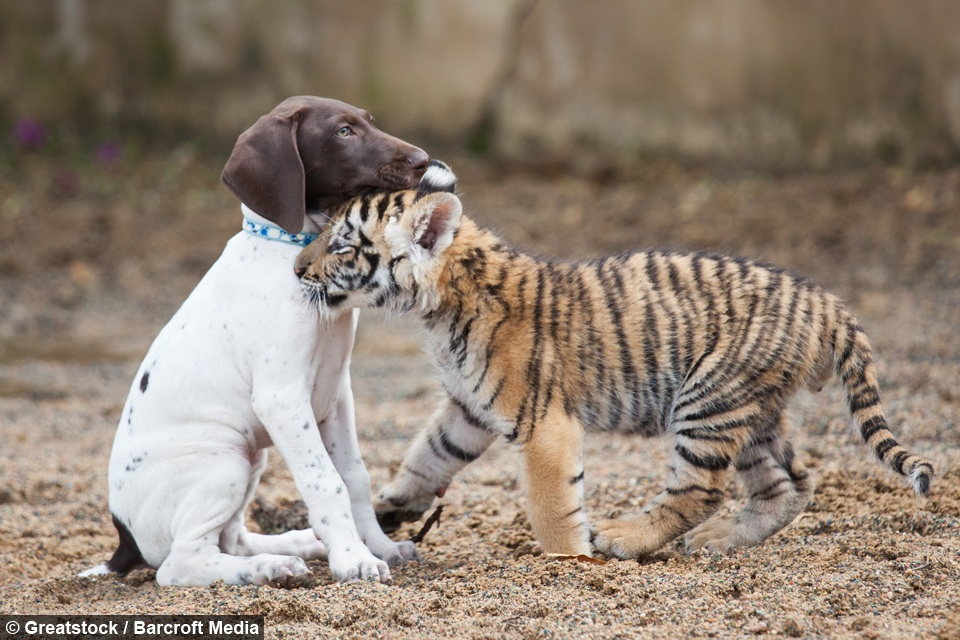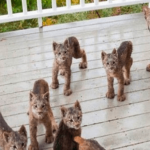
Friendship is aware of no bounds, whether or not that’s age, race, ethnicity, faith, or on this case, species, writes
Take this Bengal tiger cub names Hunter, and German Pointer pet named Chelsea, regardless of their clear variations they grew to become the perfect of associates.
Chelsea is just three weeks older than hunter and each are below the care of the Wildlife Sanctuary in Pretoria, South Africa.

Sadly, the tiger cub Hunter was rejected by his personal mom a number of days after he was born.
Sadly, his mom began displaying aggressive habits in the direction of him which meant he needed to be separated from her.
“We consider that Hunter was born at a time when the feminine will need to have felt compromised not directly as she rejected him,” Anthea Michaletos, volunteer on the sanctuary mentioned.

Because of Anthea, these little fellas at the moment are inseparable. “Within the mornings once I take Chelsea out, she’s going to run to his cage and greet him,” she mentioned.
“There’s a variety of wrestling concerned, Chelsea pushes him over after which he jumps on her.
For him to have a 4 legged buddy could be very useful as a result of he can play in the identical method that he would with one other litter mate.

He was the one cub in his litter and it’s crucial for him to have a companion.”
Companionship is essential, the pet even turns into unhappy every time it’s time for them to separate throughout the day.
This unlikely duo spend a variety of their time enjoying collectively below the caretaker’s supervision.

Sadly although, based on Anthea, this bond might finish in a number of months when Hunter reaches the age of six-months the place will probably be harmful for Chelsea in the event that they proceed enjoying.
To date although, Chelsea doesn’t present indicators of discomfort, and their fantastic friendship can proceed on.
This story initially appeared on
What 5 traits do all animals have in frequent?
What 5 traits do all animals have in frequent?
Within the following slides, we’ll discover the fundamental traits shared by all (or at the very least most) animals, from snails and zebras to mongooses and sea anemones: multicellularity, eukaryotic cell construction, specialised tissues, sexual replica, a blastula stage of growth, motility, heterotrophy and possession …
What traits do all animals have in frequent quizlet?
The six traits that each one organisms within the animal kingdom share are: they’re multicellular, virtually all can transfer, their cells don’t have any cell wall, they must hunt for their very own meals (shoppers), they’re eukaryotic, reproduce sexually-when two cells be part of to kind off spring and their cells lack chloroplasts.
What 4 traits do all animals share?
Most animals share these traits: sensory organs, motion, and inside digestion. All of them are illustrated in Determine under. Animals can detect environmental stimuli, reminiscent of gentle, sound, and contact. Stimuli are detected by sensory nerve cells.
What are the 7 traits of all animals?
- 1 Vitamin. Residing issues absorb supplies from their environment that they use for development or to offer power.
- 2 Respiration.
- 3 Motion.
- 4 Excretion.
- 5 Development.
- 6 Copy.
- 7 Sensitivity.
What are the 6 traits frequent to all animals?
They’re as follows:
- All animals are made up of cells that shouldn’t have cell partitions.
- All animals are multicellular organisms.
- Most animals reproduce sexually.
- All animals are able to self-propelled movement in some unspecified time in the future of their lives.
- All animals are heterotrophic and should devour different organisms for power.
What protein do all animals have in frequent?
The exctracellular protein collagen (making essentially the most plentiful extracellular protein in animals) which is required in multicellular organisms to maintain the cells collectively, which is unique to animals. Most enzymes chargeable for metabolic pathways.
What are the three traits of animals?
Traits of Animals
- Animals are multicellular organisms.
- Animals are eukaryotic.
- Animals are heterotrophic.
- Animals are typically motile.
- Animals possess specialised sensory organs reminiscent of eyes, ears, nostril, pores and skin, and tongue.
- Animals reproduce sexually.
What are the fundamental traits of all animals?
Within the following slides, we’ll discover the fundamental traits shared by all (or at the very least most) animals, from snails and zebras to mongooses and sea anemones: multicellularity, eukaryotic cell construction, specialised tissues, sexual replica, a blastula stage of growth, motility, heterotrophy and possession of a complicated nervous system.
What do all animals have in frequent with one another?
Sexual replica is one other attribute shared by most, however not all, animals. No matter species, all animals share multicellularity, which suggests their our bodies include a number of cells. This units animals aside from organisms, reminiscent of single-celled algae, fungi, micro organism and different primary life kinds.
What do crops and animals have in frequent?
Most crops are additionally multicellular, so though this can be a attribute shared by all animals, it isn’t one distinctive to animals.Each animal on the planet is a eukaryote. A eukaryote is an organism that consists of cells which have membrane-bound nuclei and organelles.
What are the traits of the animal kingdom?
All animals are eukaryotic, multicellular organisms, and most animals have complicated tissue construction with differentiated and specialised tissue. Animals are heterotrophs; they need to devour residing or lifeless organisms since they can’t synthesize their very own meals and might be carnivores, herbivores, omnivores, or parasites.



